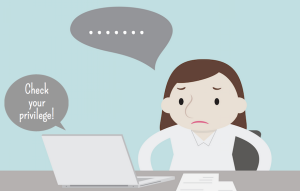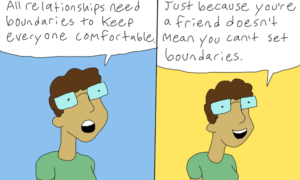
Source: Getty Images
I remember it more clearly than I want to – the memory of being forced to acknowledge the illness that my diet had spiraled into.
We were at a pizza place, my friend Rob* and I. Both having hailed from the Northeast but currently living in Atlanta, going out for pizza was a big to-do, if only because a genuinely good pie was hard to find.
I remember what we ordered: a spinach and broccoli pizza, oozing with mozzarella on a crisp-on-the-outside, soft-and-steamy-on-the-inside sweet water crust.
And despite everything that was going on, between his dating adventures (he claimed to have OKCupid down to an art form) and my working full-time as a high school teacher, the only topic that I had energy to talk about was calories.
“This is how much I ate yesterday, and this is how much I ate today, and this slice probably has this many calories in it, and I’ll have to work out for this long tomorrow to make up for it.”
The sound coming from my mouth resonated as Charlie Brown’s teacher in the ears of anyone listening.
A grimace passed Rob’s face, somewhere on the spectrum between annoyance and genuine concern, and he looked me right in the eye when he said: “I think you have a problem.”
The rest of the story, of course, is ancient history, as far as I’m concerned. It still took me months to get the help that I needed, but at the end of the day, the catalyst to my eating disorder recovery was that day.
It was the day that someone finally had enough nerve to stand up to me and tell me the truth.
And as such, I am always quick to thank people – both as an educator and as an eating disorder survivor – for being brave enough to ask about how to help their loved ones.
Because even though it feels like an uncomfortable situation to be in, it’s extremely important for people with eating disorders (or who are in the process of possibly developing an eating disorder) to have people looking out for them.
And if you’re here, reading this now, maybe someone that you love is having some trouble regarding weight, body image, food, or exercise. And it’s awesome that you’re tuned in enough to notice the difference between a diet and an eating disorder.
Thank you for noticing the warning signs.
But question is: Now what?
You noticed a problem. You started to do the research. You want to make a lasting impact on the mental and physical well-being of this person that you love…
But where do you start?
Well, the best steps that you can take are to educate yourself, learn how to best support your friend, and then come up with a game plan for how to get your friend the help needed.
Here’s how.
1. Educate Yourself
The truth is: One of the best things that you can do for your loved one is to educate yourself on what, exactly, might be going on, so that you’re armed with good information before trying to approach the subject.
Luckily, the National Eating Disorder Association (NEDA) has an amazing resource list with information for everything from contributing factors and prevention to recovery – for each and every eating disorder there is.
It’s a great place to explore if you want to learn more about eating disorders and the behaviors associated with them – and to unlearn some of the myths that you may have accidentally picked up along the way.
It’s even an important step to gain the vocabulary necessary to talk about eating disorders.
For example, you wouldn’t want to approach someone by using the words “bulimic” or “eating disorder,” especially since you can’t diagnose your loved one yourself.
Rather, you’ll want to discuss the behaviors that you’re concerned about, using words instead like “bingeing” and “purging.”
But you won’t understand how to have those conversations if you don’t first know the language.
So do the research!
Also, amazingly, NEDA has recently come out with an online screening to see if one’s thoughts and behaviors are in line with the symptoms of an eating disorder.
Answer the questions as if you are your friend, based on what you know secondhand from listening and experiencing, and see what results come up and what it tells you.
Keep in mind, though, that even if it says that it doesn’t sound like your friend is suffering from an eating disorder, it’s still worth talking about getting help for the issues that are being experienced. And going through the online screening process will give you a good idea of the symptoms and language that you need to know.
2. Support Your Loved One
It’s important to think of this process as supporting someone, rather than as getting someone help.
As such, it’s vital to the success of the process that you understand the many, many ways that you can support your loved one so that when they eventually (hopefully) do choose a path, you know how to help them on that journey.
One way to do that is to first arm yourself with resources.
Find out what kind of help is available in your area.
If you live in or near a large city, there should be government and community organizations that deal with body image and eating disorder that you can research.
If you’re in college, there are likely people on staff in the Student Health Center who are professionals in eating disorders that you could talk to.
If you’re in high school, you can talk to a guidance counselor.
You can even check NEDA’s list of resources here.
Talk to people. Get some brochures. Discuss with professionals what kinds of options are available for your friend.
In the meantime, talk to the people closest to your loved one – their partners, parents, or friends. Let them know what your concerns are. See what their thoughts are and how they think they can help the situation.
Use the research that you’ve done to back up your concerns. See if you can get a team together that’s looking out for your friend’s well-being.
The more people you have working together, the better. And this group can form the basis of your loved one’s support system in recovery.
3. Talk About It
Okay. Now that we’ve got all of the information out of the way, we can focus on what you’re supposed to do now that you want to help your friend.
Just like any sensitive issue, especially one that revolves around someone’s behavior, this is difficult terrain to treat.
You want to make sure that you frame your concern in a way that is supportive, rather than accusatory.
One way to make sure that you do that is to use I-statements.
That is, frame your sentences in such a way that you’re expressing how you feel, rather than making judgments about how your friend feels.
“I’ve been feeling a little concerned about your eating habits lately,” for example.
Or: “I felt uncomfortable the other day when you said such-and-such about your body. Can we talk about it?”
Let your friend know that you’re concerned without backing them into a corner.
Remember to give them the option not to talk about it. Don’t press the issue.
Just remind your friend every once in a while that you’re still concerned and would still like to openly discuss the behaviors or thought patterns that you’re seeing.
Feel free to leave them information here and there – a brochure about anorexia, a copy of a book about eating disorders (like Harriet Brown’s Brave Girl Eating) or positive body image (like Body Outlaws, edited by Ophira Edut). Offer to watch documentaries, or send them a list of recovery websites.
Make it clear that you’re willing to help whenever they’re ready.
—
Above all: Give your friend time and space.
Like any problem, people don’t get help until they can first admit to themselves that they have a problem. And that can take awhile.
So stay supportive.
Listen when it’s time to listen. Talk when it’s time to talk.
And never stray from being the perfectly awesome person that you already are.
Your loved one is lucky to have you.
[do_widget id=”text-101″]
Melissa A. Fabello is the Editor at Everyday Feminism. She’s a feminist blogger and vlogger, as well as an online peer sex educator, based out of Philadelphia. She is a second-year graduate student, working on an M.Ed. in Human Sexuality. She can be reached on Twitter @fyeahmfabello and Tumblr. Read her articles here and book her for speaking engagements here.
Search our 3000+ articles!
Read our articles about:
Our online racial justice training
Used by hundreds of universities, non-profits, and businesses.
Click to learn more




















